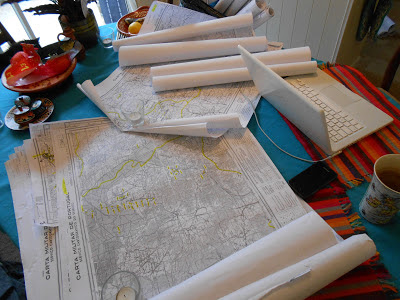Standby! Team Stork are waiting excitedly for news about funding...
 Initial meetings have gone well and we should hear in a few weeks whether the funds will be released for us to attach more loggers to adult storks on Portuguese landfills this winter. I wont jinx it by saying any more about it now, just know that we are all very excited and have been tentatively getting ready to spring in to action the moment we get confirmation to go ahead.
Initial meetings have gone well and we should hear in a few weeks whether the funds will be released for us to attach more loggers to adult storks on Portuguese landfills this winter. I wont jinx it by saying any more about it now, just know that we are all very excited and have been tentatively getting ready to spring in to action the moment we get confirmation to go ahead.
Reading over wintering stork rings, Portimao landfill,
on a gorgeous hot day in November. Chilly, damp UK
in November or Portuguese landfill in November?
Its a no brainer!
 This will sound very wrong to non birders (and some birders too) but I have been missing landfill! Not the stench, or the mud with the dubious bubbling black pools and the bits of unrecognisable floating stuff, but the ring reading. A whole day can fly in a flash by hunting back and forth through the ever changing sea of white stork legs hunting for those illusive colour rings!
This will sound very wrong to non birders (and some birders too) but I have been missing landfill! Not the stench, or the mud with the dubious bubbling black pools and the bits of unrecognisable floating stuff, but the ring reading. A whole day can fly in a flash by hunting back and forth through the ever changing sea of white stork legs hunting for those illusive colour rings!
Yum! A circuit board!
One of these fellas is colour ringed but the legs
closed over it by the time I got out my camera.
Here are some landfill photos to get you all excited with me!
http://www.cr-birding.org/node/85
Letting you in to a secret here, if the funding doesn't come off I am thinking of taking some holiday and booking a long weekend in Portugal just to read rings on landfills!
Above: Beja Landfill, where storks almost outnumber bags
of garbage. There is always a good haul of colour
rings after a day here with a telescope.
Above: Taboueira landfill, Aveiro Above: Taveiro landfill, Coimbra
Due to EU directives, open landfills are closing. Aveiro and Coimbra have already closed and sealed -like the mound on the right in the Coimbra photo (above). Reading rings, both gulls and storks, will be a lot trickier in the future once scavenging on landfill is no longer possible and the birds disperse over the countryside.
 |
All the gulls flush accompanied by the thunder of poo on plastic....
...far from shelter the only thing a ring reader can
do is improvise cover and wait for the flock to pass
over, hopefully without too many direct hits.
Daniel Cadwallader knows whats coming!
Left: Preparing to catch storks. Ines Catry and Carlos Pacheco deploy the clap net at Alvito landfill, Right: a captured stork is hooded to prevent stress whilst the logger harness is fitted.
Jose Alves, Phil Saunders and Daniel Cadwallader
reading rings at Evora landfill whilst waiting for a
stork to walk in to the traps.
Letting you in to a secret here, if the funding doesn't come off I am thinking of taking some holiday and booking a long weekend in Portugal just to read rings on landfills!














































